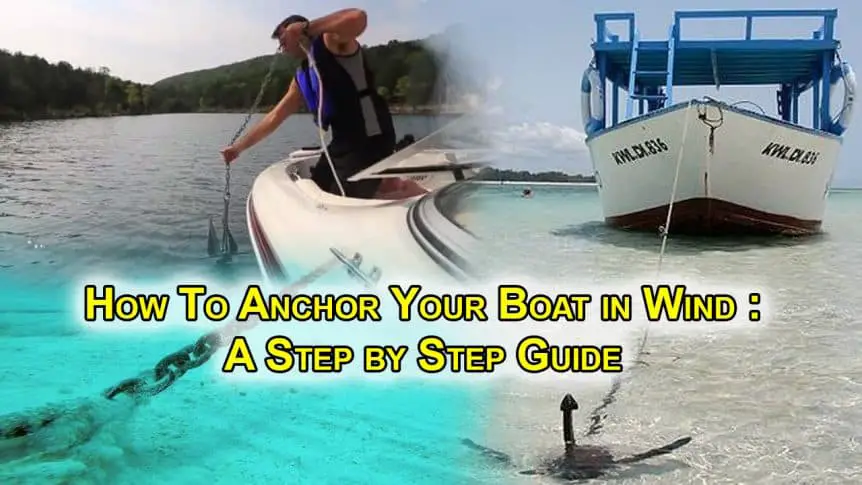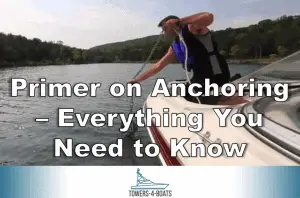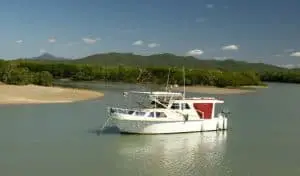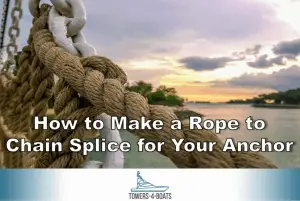Mastering One of the Most Important Boating Skills
Anchoring is one of those fundamental boating skills that some boaters practice far too little. The anchor on your boat is fundamentally a safety device. It should be rigged and ready to drop in the water at a moment’s notice should you have an engine failure or other problem. If you’re near shore when something happens, you won’t have time to find and assemble your anchor and line.
But of course, anchors aren’t just for emergencies. We anchor our boats for a number of reasons. Maybe we’re spending the night camping aboard while looking at the stars from a quiet cove. Or maybe we’re traveling down the ICW, gunkholing off of little towns. Or perhaps we’ve just stopped by our favorite swimming hole and are enjoying a six-pack. Read my related article on anchoring on a beach.
Anchoring isn’t all that challenging, but unfortunately, it’s easy to do it wrong time and time again, only to learn that it was wrong when something goes badly. The wind might pick up, another boat might get too close, or the bottom might be too rocky. Whatever it is, it’s better to do it right the first time rather than to find the weak spots during a thunderstorm at 2:00 a.m.
Step by Step to Anchoring like a Pro
1. Have a Plan and Be Ready
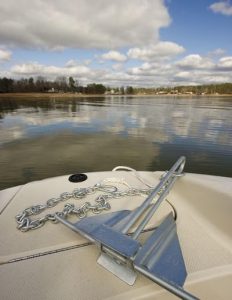 Like pretty much any aspect of boating, you should have a plan before you head into the anchorage. Pick the best anchor you have onboard for the bottom you expect to find there. Bottom composition is easily found on charts, in cruising guides, or on websites like Active Captain.
Like pretty much any aspect of boating, you should have a plan before you head into the anchorage. Pick the best anchor you have onboard for the bottom you expect to find there. Bottom composition is easily found on charts, in cruising guides, or on websites like Active Captain.
Your anchoring equipment should be set up and ready to go before you approach the anchorage. Your anchor line should be marked in 20- or 25-foot increments, so that you can put out the appropriate amount of line.
Knowing the weather forecast is important too. Which direction is the wind coming from, how strong will it be, and is it expected to shift? When picking your spot to anchor, you want to be out of the wind as much as possible. The most dangerous place to anchor is on what is called a lee shore. If anything goes wrong here, the wind will push you up onto the beach. You want the wind blowing away from land so that if anything goes wrong, you are blown into deeper water and away from land. As a bonus, this means that you will be in the wind shadow of the land, which will reduce the wind and waves. Calm anchorages are happy places.
You’ll also need to know what the state of the tide is and what the range is going to be. You want to anchor in water as shallow as possible, but you don’t want to risk being aground at low tide. And should the wind shift another direction, you don’t want to swing over shallow water that might make problems when the tide decreases. You also need to know the maximum depth you’ll be in to figure out how much anchor line to put out (more on that later).
2. Pick Your Spot in the Anchorage
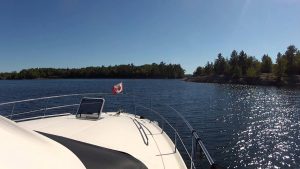 Even within an anchorage, some spots have better protection than others. Pick the spot with the best wind protection that has deep enough water that you will never have to worry about touching bottom.
Even within an anchorage, some spots have better protection than others. Pick the spot with the best wind protection that has deep enough water that you will never have to worry about touching bottom.
You’ll want a spot that’s away from other boats, and away from shallow spots. If you’re staying more than a few hours, plan to have room no matter which way the wind will come from.
We’ll discuss more on picking your spot in the anchorage and dealing with other boats in a future article. But always give yourself lots of space to swing around your anchor as the wind shifts.
3. Head into the Wind and Drop the Hook
Once you’ve got a solid idea of where you want your boat to be, head into the wind and drop your anchor 50 to 100 feet ahead of your chosen position. Come to a stop, and then let the boat begin to drift back. Drop the anchor as the boat starts to drift backward. You might need to use small amounts of power and rudder to keep the bow into the wind, but use care to allow the boat to continue moving backward. If you don’t, your anchor chain or rode will wind up in a pile on the bottom, and it could foul your anchor.
Check out this YouTube video about Anchoring in the Wind from our friends at yamahawatercraftusa.
4. Ensure the Anchor is Set
Play out about half of the line you expect to use. Tie it off to a bow cleat and allow the boat to come to a stop. You want to make sure the anchor digs into the bottom and will hold the boat, no matter what the wind does. To this end, back down on the anchor with reverse power. As the anchor line comes taut, put the boat into reverse, and gradually add power. Hold some power in reverse for 30 seconds or more, and make absolutely sure you are not moving. You can use your GPS to confirm or watch for landmarks nearby that show any movement in your position.
If the anchor does drag, let out a little more line and try again. If it’s just bouncing along the bottom and not grabbing, plan on trying a different spot. A different type of anchor might help, as well.
5. Play out Sufficient Scope
Once the anchor is set, you need to let out more line. The anchor’s true holding power comes from the amount of line you put out. If you expect stronger winds, you need to put out more line. The amount is referred to as the scope, and you need to use a different amount every time you anchor.
To figure out the appropriate amount of scope, you need to know a few factors. You need to know how deep the water is (or will be as the tide comes in), and you need to know how high off of the water surface your bow roller is.
For example, you pull into a cove to spend the night, and the depth sounder says the water depth is six feet. You know that it’s low tide and that another three feet will be added to that. Your anchor roller is three feet off of the water, giving a total of 12 feet from your anchor roller to the bottom at high tide. With that number, multiply by the amount of scope you need. For a boat with all chain, the standard ratio for normal conditions is five feet of line for every one foot off of the bottom, or 5:1. Since 12 times 5 is 60 feet, you need to play out 60 feet of line.
The amount of scope depends on the type of rode you use. For standard conditions, all chain rodes should use a scope of 5:1, and nylon line rodes should use 7:1. If serious winds are forecast, 10:1 is appropriate. Even if you can get away with less scope in calm conditions, it’s always best to prepare for the worst. Always anchor like it’s going to blow 50 knots, even if you don’t think it is. Those summer thunderstorms can pop up fast.
With this in mind, you can see why it makes sense to anchor in shallow water. Most boats only carry 150 or 200 feet of anchor line. The deeper the water, that greatly limits the amount of scope you can put out.
6. Don’t Be Ashamed to Make a Go Around
Airplane pilots know that every landing can end in a “go-around,” and only if they do every little thing right will they get to land. Go-arounds are simply do-overs. If you’ve dropped the hook, and now you’re so close to that sailboat that you can see them giving you the stink eye, it’s time to initiate a go-around. Every boater gets it wrong now and again. Maybe the wind wasn’t coming from the direction you thought it was, there was a nasty cross-current, or you just misjudged how much line you needed to put out. No harm, no foul. Just “go around” and try again.
7. Secure the Boat and Maintain and Anchor Watch
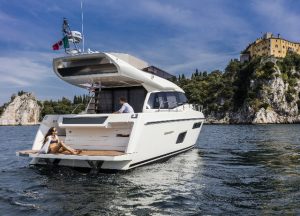 Once the anchor is set and you’re happy with your positioning, you can make yourself at home. But just because you’re anchored doesn’t mean you get to stop boating. If the wind is piping up and you’re riding out a blow, you need to keep a careful eye on conditions and ensure that your anchor does not drag. Never put too much blind faith in your anchor, in the holding power of the sea bed, or your equipment and setup. You can use compass bearings and a chart to ensure you don’t move. Most GPS chartplotters have an anchor drag alarm feature that makes a convenient backup. There are also smartphone apps that can serve the same function.
Once the anchor is set and you’re happy with your positioning, you can make yourself at home. But just because you’re anchored doesn’t mean you get to stop boating. If the wind is piping up and you’re riding out a blow, you need to keep a careful eye on conditions and ensure that your anchor does not drag. Never put too much blind faith in your anchor, in the holding power of the sea bed, or your equipment and setup. You can use compass bearings and a chart to ensure you don’t move. Most GPS chartplotters have an anchor drag alarm feature that makes a convenient backup. There are also smartphone apps that can serve the same function.
Always remember to show an anchor light if you are staying the night. If you are near busy waterways, showing the day shape “anchor ball” is a good idea too.
Conclusion
Some of the best times you can have on a boat are when anchored. Being confident in your abilities and equipment to anchor your boat opens up a new world of places to explore and things to do. With a little reading up and some practice, every skipper can anchor like a pro.

